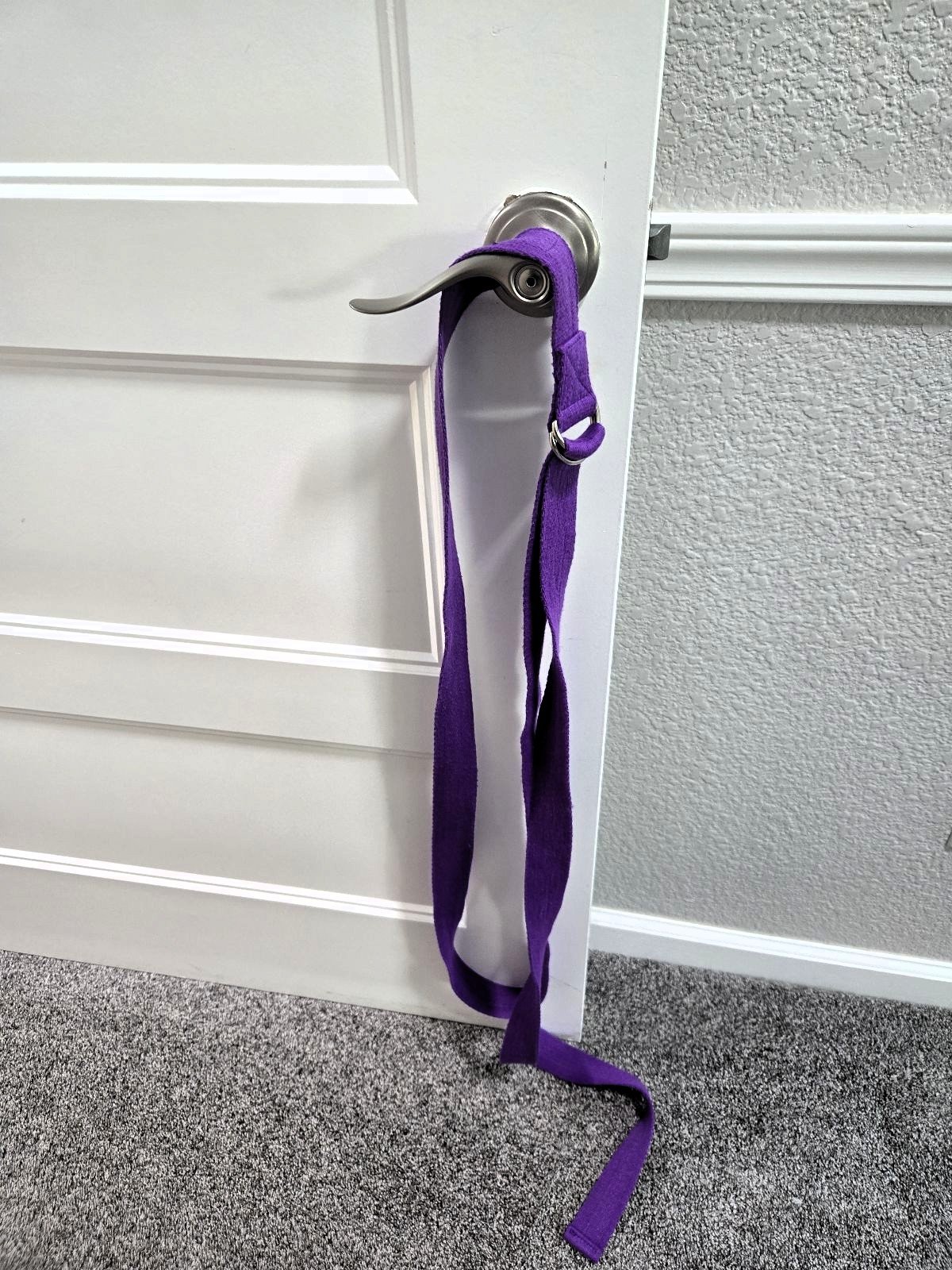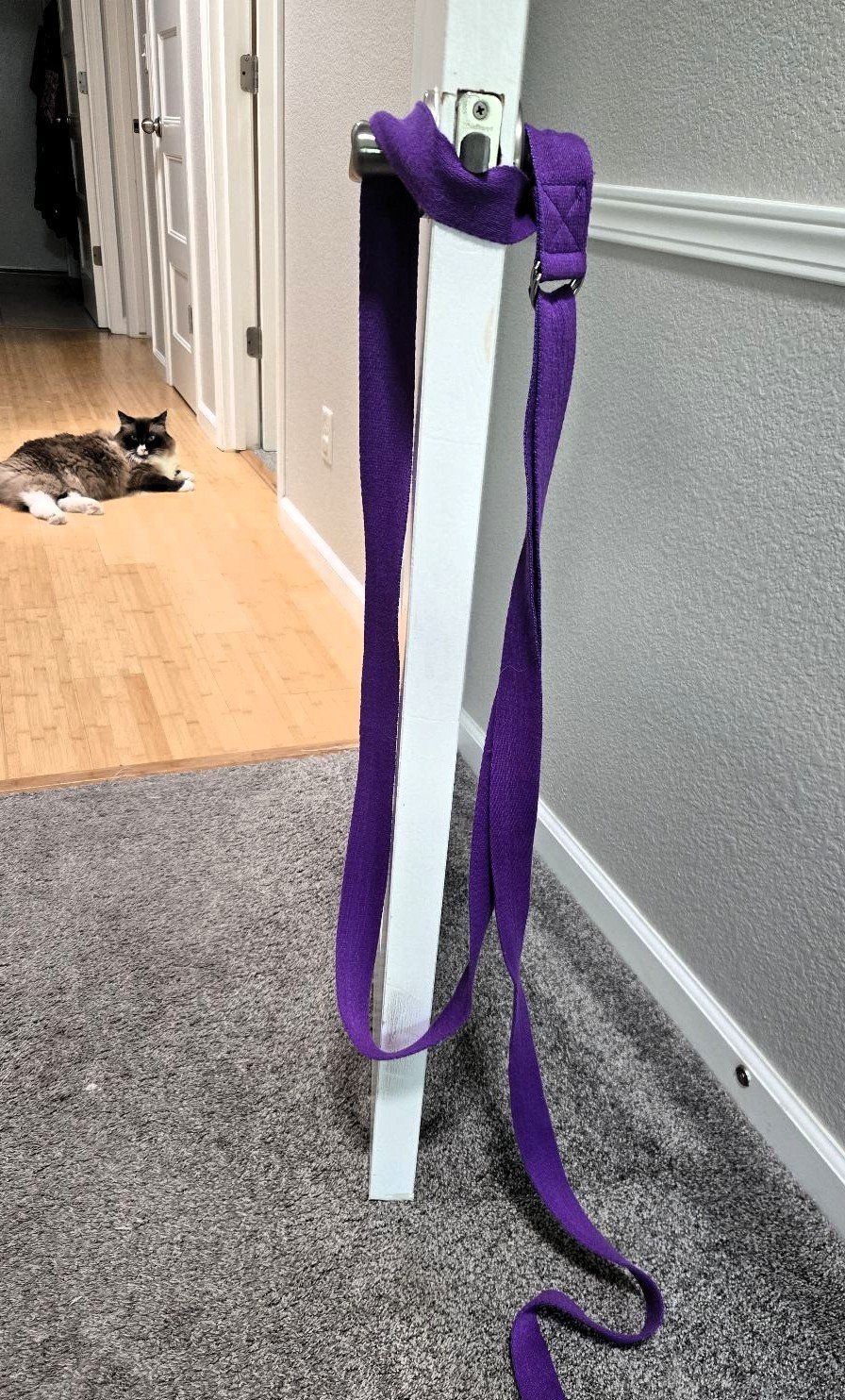How to Traction Your Downward Dog with a Yoga Strap
/Downward-Facing Dog (Adho Mukha Svanasana) is a common pose in many yoga practices, offering a stretch for the hamstrings, calves, and shoulders while strengthening the arms and legs. It is great for improving posture and therapeutic for those with body imbalances. It offers equal amounts of stretching and strengthening, which makes it an ideal pose for improving mobility and reducing pain. Because this pose is part inversion and part arm balance, it places a lot of weight in the hands, wrists, and shoulders. Certain pre-existing conditions or injuries of these body parts might require modifying the pose or skipping it all together. (If you have pain in this pose, you can check out my post on the topic.)
There are several variations and modifications for Downward Dog. One of the best—and essential for individuals with scoliosis or leg length discrepancies—is using a long yoga strap to provide traction for your spine and alignment for the hips.
This technique uses external support to create a gentle pull on the front of the hips, helping to decompress your spine and give you a sensation of spaciousness you might not typically achieve in the pose. It’s particularly beneficial if you feel compression in your lower back or struggle to find length in your spine during Downward Dog. One of the core tenants in doing yoga for scoliosis is lengthening the spine, which makes this variation even more beneficial.
Why Add Traction to Your Downward Dog?
The benefits of traction lie in its ability to counteract gravity’s downward pull on your spine. As a result, you get
Spinal Decompression and Lengthening: The gentle pull helps to create space between your vertebrae, potentially relieving pressure and increasing flexibility and length through your torso.
Improved Alignment: With the support of the traction, it becomes easier to find optimal alignment in your hips, legs, arms, and back, allowing you to settle more deeply into the pose.
Released Tension: Many of us hold tension in our backs. Traction can encourage a release of this chronic tightness, leading to greater comfort and ease.
Deeper Stretch: By creating more space, you can often achieve a deeper and more effective stretch in your hamstrings and shoulders.
How to Practice Downward Dog with Traction


1. Set Up Your Strap
Find a door handle that is securely attached and a door that opens into enough space for you to perform Downward Dog in front of it.
Take your long yoga strap and make a loop that is about the length of your legs. Loop it around the door handle, making sure it’s secure and won't slip.
Loop the several-foot-long oval strap around both sides of the door handle, making sure it is secure and won’t slip. Keep the strap buckle near but not on the handle so it doesn’t loosen the strap through contact with the handle or your body.
2. Position Yourself
Standing in front of the door, lift the strap over your head. Note: Resist the urge to step in—it can increase your risk of falling.
Facing away from the door, loop the yoga strap around the front of your pelvis, just below your hip bones. Ensure the strap is snug but not uncomfortably tight.
Bend forward, walking your hands forward and your feet back, coming into a traditional Downward Dog shape with your hands about shoulder-width apart and your feet hip-width apart.
3. Find Your Traction
As you lift your hips toward the ceiling, mooning the door edge, press your heels down toward the ground. They may not make it and that’s okay! You’ll feel the strap leveling the front of your hips and gently pulling them back away from your hands.
Allow this traction to provide a lengthening sensation through your spine. Imagine your tailbone reaching up and back, while your chest melts toward your thighs and your head extends toward a spot a foot or so in front of you. If you have scoliosis, you will be inclined to drop your head. However, focus on keeping it long and in line with the rest of your spine.
Keep your arms strong and straight, pressing firmly through your palms.
Gently engage your core to support your lower back. Though this pose strongly works the back of the body, notice the sensations in the front as well. See if you can feel a stretch through the abdomen. This pose creates spaciousness and blood flow in the pelvis, which can help reduce reproductive and digestive issues.
4. Breathe and Release
Breathe deeply, allowing each exhale to help you sink further into the stretch and release any remaining tension.
Stay for 5–10 breaths, or as long as it feels comfortable and beneficial.
5. Come Out
Slowly walk your hands back toward your feet and your feet up toward your hands.
Once your hips are over your ankles, and if you have the strap still wrapped around the front of your hips, place your hands on your hips. Keeping a long and straight spine, use the resistance of the strap to come back up.
If you don’t feel comfortable lifting up with the strap around your hips, have a chair nearby to help yourself up or release the strap from your hips before coming up.
Stand in Mountain Pose for a few breaths to experience the feelings of length and spaciousness in your spine before moving on.
Notes
For scoliosis: Focus on lengthening your concavity and de-rotating your spine. For example, for a right thoracolumbar curve, your concavity is on the left. Breathe into and find length in that collapsed area. Your right thoracic area is likely rotating to the right and is further back than the left side. Slightly encourage de-rotating that right side so the top of your back looks more even. If you have a protruding right shoulder blade, for example, you may need to move the right hand out away from your midline some to help it drop and be more level.
For leg length discrepancy: This pose with strap traction is essential for those with leg length discrepancies. Because of this discrepancy, the hips are uneven and are often torqued forward or back. The strap initiates alignment through the front of your hip, which will help your body find a sense of balance. However, because your legs are different lengths, one foot might be more forward than the other. This is okay and expected. You want the feet to be in different locations and it can help you visualize the length discrepancy.
Incorporating traction into your Downward Dog can transform this fundamental pose and offer a deeper sense of ease and alignment and provide postural feedback that is essential for those with scoliosis and leg length discrepancies.



